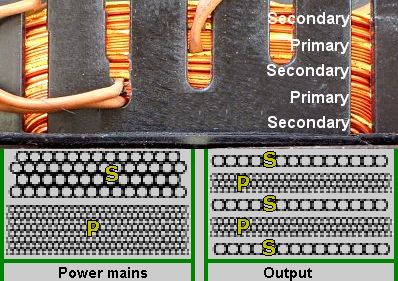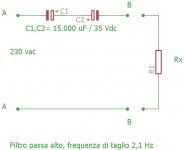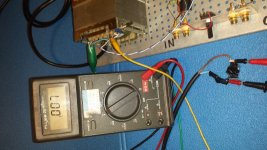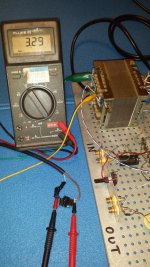I buy an export grade double insulation wire that comes in reels of 25Kg, when they fraction it the tension on the wire is huge (old machine with bad bearings) and a 4% stretching is not rare in thin wires, winding by hand adds even more tension, anyway a 4% error (manufacturer tolerance is about 2.5%) is negligible compared with information provided by the OP. 😉
Maybe look for a better supplier then 🙁.
With 4% stretching of thin wires you are on the edge of breaking.
With a normal but good winding machine (mine is over 60 years old....) you can control the wire tension without stretching.
Have you anything to add about the use of Litz wire?
I am reluctant about it, but in my opinion the experiment is useful when done right (that's why I keep on asking Walter....).
Sometimes things are audible but not measurable 😕
It is OT
But I wrote one article about the presence of dc on primary of a trafo.
If you connect a, p.e. an hair dryer, close to one power trafo you can see the dc components.
On these stuff to obtain the half of power most of them have a single diode in series with the 220 vac ( in my case), this will create a disturb.
So you can get this the wave as fig. 6 in attch where we have the current that flow in the primary with the dc component
In fig 5 the same without dc.
to avoid this you can use the solution in fig.7 where rx is the trafo, in this case the dc components is blocked.
That all, stop OT, for me.
Walter
But I wrote one article about the presence of dc on primary of a trafo.
If you connect a, p.e. an hair dryer, close to one power trafo you can see the dc components.
On these stuff to obtain the half of power most of them have a single diode in series with the 220 vac ( in my case), this will create a disturb.
So you can get this the wave as fig. 6 in attch where we have the current that flow in the primary with the dc component
In fig 5 the same without dc.
to avoid this you can use the solution in fig.7 where rx is the trafo, in this case the dc components is blocked.
That all, stop OT, for me.
Walter
Attachments
Cheap hair dryer uses a low voltage DC motor in series with a diode. This is a DC component across the line. Most "elaborate" uses a 4 diode or molded bridge unit. But in any case, it generates disturbs in two ways, motor collector commutation, nearly proportional to speed, and another synchronized with line every time line voltage plus voltage drop in the resistance equals tacho generated voltage by the motor itself.
Walter,
Could you please bring up the politeness to reply on my question post 264??
When English language is a problem for you please consult someone around you who can help you if you don't understand my questions.
By not replying you are disrespecting the most basic conditions for discussion.
Could you please bring up the politeness to reply on my question post 264??
When English language is a problem for you please consult someone around you who can help you if you don't understand my questions.
By not replying you are disrespecting the most basic conditions for discussion.
Pieter,
on spec is written ( on the bobbin got from manifacturer of wire) ) 0,31 mm of diameter
Honestly I have't measured it personally, I will ask to the man that wound the trafo.
Each turn has about 26 cm of lenght (average)
Please have you some test to show about the trafo, so I can understand the other stuff better than I have presented; there too many words (some of them are very interesting, written p.e. by 45) about this arguments but nobody sent a practical test on trafos.
And it is not acceptable, in my opinion.
Walter
on spec is written ( on the bobbin got from manifacturer of wire) ) 0,31 mm of diameter
Honestly I have't measured it personally, I will ask to the man that wound the trafo.
Each turn has about 26 cm of lenght (average)
Please have you some test to show about the trafo, so I can understand the other stuff better than I have presented; there too many words (some of them are very interesting, written p.e. by 45) about this arguments but nobody sent a practical test on trafos.
And it is not acceptable, in my opinion.
Walter
Last edited:
Core V51 is equivalent to SG 89/51, which has average winding length of 23,7 cm / turn.
In my database, core V51 has an average turn length of 26cm
The V51 core has about 23.5-24 cm average turn length depending on how much of the available height one uses. 24 cm is really full!
Each turn has about 26 cm of lenght (average)
So far we have three guesses, hope that your numbers do not fluctuate again. 🙄
Please have you some test to show about the trafo, so I can understand the other stuff better than I have presented; there too many words (some of them are very interesting, written p.e. by 45) about this arguments but nobody sent a practical test on trafos.
Your test routine was fine, your experimental procedure was awfully wrong.
Just make two transformers, the more similar possible, one with magnet wire and the other with Litzendraht wire.
Hint: Instead of Mylar (ε=3.3) try to use Nomex 410 (ε=1.6 for 0.05mm)
Not least important, make pictures as on post#277, today newspaper will not be necessary.
So far we have three guesses, hope that your numbers do not fluctuate again. 🙄
Your test routine was fine, your experimental procedure was awfully wrong.
Just make two transformers, the more similar possible, one with magnet wire and the other with Litzendraht wire.
Hint: Instead of Mylar (ε=3.3) try to use Nomex 410 (ε=1.6 for 0.05mm)
Not least important, make pictures as on post#277, today newspaper will not be necessary.
Hey Juan I am pretty sure about the turn lenght. I have designed a pair of OT's for a friend of mines just a couple of months ago on that core (best quality M6)! With standard coild formers you find here the window for the core is 29x53 mm, the width of the winding space is 56 mm, the height is 19.8 mm and the tickness of the former is about 2 mm. 3.4K 5W transformers for the 2A3: 2600 turns with 0.355 wire (0.414 mm overall) + all the rest occuping the entire 19.8 mm height. The primary Rdc was about 108R.
Pieter,
on spec is written ( on the bobbin got from manifacturer of wire) ) 0,31 mm of diameter
Honestly I have't measured it personally, I will ask to the man that wound the trafo.
Each turn has about 26 cm of lenght (average)
Please have you some test to show about the trafo, so I can understand the other stuff better than I have presented; there too many words (some of them are very interesting, written p.e. by 45) about this arguments but nobody sent a practical test on trafos.
And it is not acceptable, in my opinion.
Walter
waltube, is it possible for you to give a picture of the cross section of your traffo? winding window and coils if you have not done it yet....
something like this...picture below is from http://education.lenardaudio.com/en/14_valve_amps_5.html

I think Walter did not designed the fraffo... he asked his supplier to do the job... that's the reason he do not has numbers...waltube, is it possible for you to give a picture of the cross section of your traffo? winding window and coils if you have not done it yet...
Hey Juan I am pretty sure about the turn lenght. I have designed a pair of OT's for a friend of mines just a couple of months ago on that core (best quality M6)! With standard coild formers you find here the window for the core is 29x53 mm, the width of the winding space is 56 mm, the height is 19.8 mm and the tickness of the former is about 2 mm. 3.4K 5W transformers for the 2A3: 2600 turns with 0.355 wire (0.414 mm overall) + all the rest occuping the entire 19.8 mm height. The primary Rdc was about 108R.
Hi Pierpaolo, totally unknown territory to me, I have C-cores from most than ten years now and so far could not find any data about them...
pieter t have almost the same data as you, core V51 is equivalent to SG 89/51, but I saw on a Chinese page that it is equivalent to SG 88/51... puzzling...
In few words I have no idea, I will take your word.
Yes, it would! But Walter is not the designer of the traffo (I suppose)... so it is very hard to have all the infos.lisofirmio, a cross section drawing, a connection diagram would have prevented much of the blabbering in this thread imho..
index

OT posts deleted. This thread is rapidly drawing toward closure given the nature and content of many recent posts.
Stick to the thread topic and post courteously. No more warnings over this.
Yes, it would! But Walter is not the designer of the traffo (I suppose)... so it is very hard to have all the infos.
yes, it looks that way to mee too...
Hi Pierpaolo, totally unknown territory to me, I have C-cores from most than ten years now and so far could not find any data about them...
pieter t have almost the same data as you, core V51 is equivalent to SG 89/51, but I saw on a Chinese page that it is equivalent to SG 88/51... puzzling...
In few words I have no idea, I will take your word.
The cores I used were made in Italy and they have the same dimensions of Japanese cores I have seen (although most of the Japanese cores are now made in China!). I think they have pretty standard dimensions almost everywhere although in some countries they do have different names (like here in the UK....where they always need to distinguish themselves from the crowd even when it is not necessary.....) but an equivalence table is always offered by the manufacturers. So it is not a problem. Chinese stuff sold by Chinese brands is going to be a mystery very likely if they do not provide full info....
cores made in china...can't beat the price...
Sure but unless you buy from a reliable source with some decent quality control and information the risk of getting rubbish stuff (for example, discarded by someone else following a specific order) is not negligible. Same as the tubes: some decent ones and a lot of rubbish....that's wasted money for me also considering that above 15 GBP I have to pay VAT and Custom tax here in the UK and that's about +38% on top of the selling price and high shipping charge because of the weight! Not worth the risk for me. Might be different for you.
- Status
- Not open for further replies.
- Home
- Amplifiers
- Tubes / Valves
- LITZ output trafo


